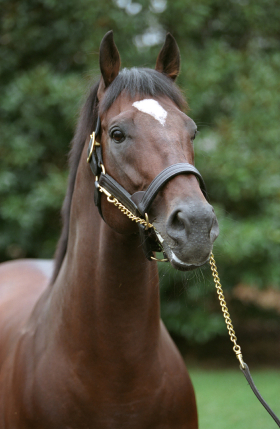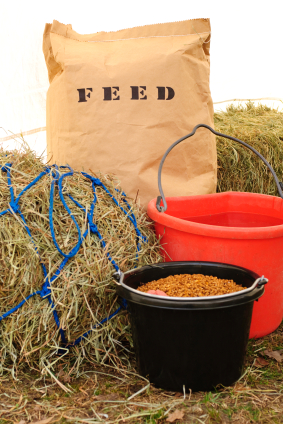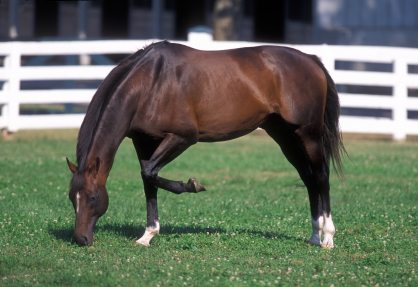 Stallions are the Hollywood stars of the breeding world. Their presence is hard to ignore. Yet behind the glamour persona, there is a job to be done. Combined with the costs of promoting a stallion, the pressure on stallion owners and managers to insure their charges are at the top of their game and able to perform on demand when brought to the breeding shed, becomes evident. The stallion himself is not exempt from feeling this stress. The life of a breeding stallion with a full book can be hard work, and may take its toll on an ill prepared stud. Nutrition plays a key role in insuring that your stallion has the best chance of a successful breeding season.
Stallions are the Hollywood stars of the breeding world. Their presence is hard to ignore. Yet behind the glamour persona, there is a job to be done. Combined with the costs of promoting a stallion, the pressure on stallion owners and managers to insure their charges are at the top of their game and able to perform on demand when brought to the breeding shed, becomes evident. The stallion himself is not exempt from feeling this stress. The life of a breeding stallion with a full book can be hard work, and may take its toll on an ill prepared stud. Nutrition plays a key role in insuring that your stallion has the best chance of a successful breeding season.
The nutritional needs of the breeding stallion during the breeding season can roughly be thought of as that of a horse of equal size in light work. As with all equine rations the first area of consideration is that of energy intake. The foundation of the ration should be good quality forage fed at approximately 1.5-2% of body weight per day going no lower than 1%. As energy needs rise, caloric intake needs to follow suit in order to maintain condition. The exact amount necessary will vary between studs depending on how easy of a keeper he is. Stallions that are nervous, that box walk, pace, are new to breeding or who are also being worked under saddle etc may have higher caloric needs. It may be possible to maintain the easy keepers with additional good quality forage, while others may need a source of more concentrated calories in the form of grain or a commercially formulated feed.
Overall, breeding stallions should maintain a body condition score of 5 throughout the season. Stallions carrying too much condition may have lowered libido but also the increased weight will add additional strain to their joints which is not advisable. Nervous stallions can be a challenge and can drop weight as they can sometimes go off feed. A number of flavorings, for example fenugreek, may entice the picky eater. These stallions may need to start the season with a slightly higher body condition score so that as they lose weight they do not become too thin.
 If grain or commercially fortified feed is used, no more than 0.75lbs per 100lbs body weight should be fed per day, and no meal should provide more than 5lbs. For pony stallions this meal size should be reduced in size accordingly. Feeding large amounts of grain raises concerns for both gastric ulcers and hindgut acidosis. However, grain is not the only trigger for ulcers. Horses kept in stressful conditions are also at greater risk, and stallions are particularly susceptible. Young stallions in their first breeding season, stallions sent to unfamiliar breeding farms, incorrect collection techniques, rough handling, territorial conflicts with other stallions in the barn, all raise a studs stress levels and increase the risks of gastric disturbance. Particularly sensitive stallions may benefit from one of the many supplements on the market that will help reduce the risk of developing gastric ulcers. Adjustments may need to be made to the stallion’s environment and management.
If grain or commercially fortified feed is used, no more than 0.75lbs per 100lbs body weight should be fed per day, and no meal should provide more than 5lbs. For pony stallions this meal size should be reduced in size accordingly. Feeding large amounts of grain raises concerns for both gastric ulcers and hindgut acidosis. However, grain is not the only trigger for ulcers. Horses kept in stressful conditions are also at greater risk, and stallions are particularly susceptible. Young stallions in their first breeding season, stallions sent to unfamiliar breeding farms, incorrect collection techniques, rough handling, territorial conflicts with other stallions in the barn, all raise a studs stress levels and increase the risks of gastric disturbance. Particularly sensitive stallions may benefit from one of the many supplements on the market that will help reduce the risk of developing gastric ulcers. Adjustments may need to be made to the stallion’s environment and management.
When a commercial fortified grain is fed as directed by the manufacturer, the stallion’s vitamin and mineral needs should be met. It is important to select a product with an appropriate daily intake that will maintain the stallion at the desired body weight when fed at the recommended feeding amount. When feeds are provided at amounts less than the recommendation it cannot be guaranteed that all vitamin and mineral requirements have been met, and additional supplementation may be necessary.
In the past, much attention has been paid to the impact of vitamins and minerals on fertility. There is no scientific evidence that fertility can be improved by increasing a stallion’s intake of vitamins E and C if the diet is already correctly balanced. Adding supplements containing minerals should be done with care and in consultation with a qualified equine nutritionist especially if also feeding a commercially fortified feed. It is possible to unwittingly disturb the balance of the diet, potentially doing more harm than good. The exception to this is salt. As with all horses, stallions should have access to plain white salt. If provided as a block, be sure that they use it, as many horses will not lick a block but will consume salt if it is provided loose.
 While supplementing vitamins E and C may not have been found to impact fertility, there is one area of supplementation that has recently been shown to improve sperm viability and motility, especially in sub-fertile stallions. Cooling and freezing semen causes cellular level injury in sperm, disrupting membrane lipids. Many livestock species have their semen processed in these ways, but not all species and individuals are equally susceptible to cellular stress. This is thought to be due to differences in sperm membrane structure, the major difference being the amount of docosahexaenoic acid (DHA), an omega-3 fatty acid. Sperm also contain docosapentaenoic acid (DPA), an omega-6 fatty acid. High DPA to DHA ratios have been linked to infertility with higher DHA being linked to increased fertility, and species with naturally higher levels of DHA handle cooling and freezing with less negative effects. Many rations fed to horses are high in precursors for DPA. Researchers from Texas A & M have demonstrated that dietary supplementation of DHA can improve mean total and progressive sperm motilities in some stallions. Perhaps of greatest importance was the impact on those stallions with existing fertility issues for whom the beneficial effects were magnified. For these stallions it was speculated that supplementation could improve semen quality by a factor great enough to make them candidates for cooling and freezing. If you are unsure as to whether your stallion would be a good candidate for DHA supplementation you may wish to consult your veterinarian.
While supplementing vitamins E and C may not have been found to impact fertility, there is one area of supplementation that has recently been shown to improve sperm viability and motility, especially in sub-fertile stallions. Cooling and freezing semen causes cellular level injury in sperm, disrupting membrane lipids. Many livestock species have their semen processed in these ways, but not all species and individuals are equally susceptible to cellular stress. This is thought to be due to differences in sperm membrane structure, the major difference being the amount of docosahexaenoic acid (DHA), an omega-3 fatty acid. Sperm also contain docosapentaenoic acid (DPA), an omega-6 fatty acid. High DPA to DHA ratios have been linked to infertility with higher DHA being linked to increased fertility, and species with naturally higher levels of DHA handle cooling and freezing with less negative effects. Many rations fed to horses are high in precursors for DPA. Researchers from Texas A & M have demonstrated that dietary supplementation of DHA can improve mean total and progressive sperm motilities in some stallions. Perhaps of greatest importance was the impact on those stallions with existing fertility issues for whom the beneficial effects were magnified. For these stallions it was speculated that supplementation could improve semen quality by a factor great enough to make them candidates for cooling and freezing. If you are unsure as to whether your stallion would be a good candidate for DHA supplementation you may wish to consult your veterinarian.
However, when trying to influence sperm quality do not expect immediate results. Spermatogenesis (the cycle of sperm formation in the testes) and sperm maturation in the epididymis takes approximately 65 days; this means that the beneficial results of omega-3 supplementation may take up to 3 months to be noticeable and therefore starting supplementation before the start of the season is advised.
Lastly, for older stallions who display stiffness/discomfort in their hocks, stifles etc, joint supplements may be potentially beneficial. Care should be taken when selecting a joint nutraceutical as not all products contain ingredients of equal quality. Products should be bought from reputable sources and your veterinarian or equine nutritionist should be able to make suggestions.
Stallions need to be treated as the individuals they are, and this can mean very different diets being fed from one stallion to the next. Feeding your stallion a well balanced diet of quality nutrients at an amount to maintain good body condition is the most important part of his nutritional management. This, in combination with minimizing stress both nutritional and environmental, will go a long way to insuring that he comes into the breeding shed at the top of his game.
See Also:
Is Your Stallion at Risk for Ulcers?
Nutritional Considerations for the Breeding Stallion
Dr. Clair Thunes, Summit Equine Nutrition


Log in to join the conversation.